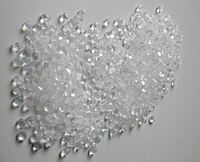
Photo from wikipedia
Abstract Time-resolved mechanical spectroscopy (TRMS) was conducted to study the thermo-oxidative degradation of linear low density polyethylene (LLDPE) samples with different thermal histories and their blends with a polyamide (PA6)… Click to show full abstract
Abstract Time-resolved mechanical spectroscopy (TRMS) was conducted to study the thermo-oxidative degradation of linear low density polyethylene (LLDPE) samples with different thermal histories and their blends with a polyamide (PA6) in the melt state. Neat LLDPE was first melt-processed at 180, 220, 250, and 260 °C in an extruder and then pre-processed LLDPE samples were further extruded with PA6 at 260 °C to form various LLDPE/PA6 blends. TRMS measurements were conducted under an air atmosphere at 0.5% strain and a constant frequency of 0.1 rad/s for LLDPE samples and at a range of frequencies between 0.1 and 60 rad/s for LLDPE/PA blend samples, over a 1 h period. In the case of LLDPE samples, time-sweep experiments were carried out at 190, 220, and 240 °C, whereas the temperature was fixed at 240 °C for the LLDPE/PA blend samples. The observed rheological behaviors revealed that the degradation resulted in an increase in the elastic moduli of the LLDPE and LLDPE/PA blends regardless of the thermal history. LLDPE processed at different processing temperatures produced different viscoelastic behaviors in cases where the LLDPE samples were processed at lower temperatures (180 and 220 °C) where a rapid increase in the modulus over a short period was seen. On the other hand, a change in the pre-processing temperature of the LLDPE had no effect on the rheological property of the corresponding LLDPE/PA6 blends. Cross-linking reactions during measurements under an air atmosphere could be the main reason for the growth in the modulus as a result of thermo-oxidative degradation. It was found that degradation was only a function of the temperature and exposure time, not the frequency. The most important result of this study was that collecting data on the isochronal moduli at different scanning frequencies was a more accurate way to understand the degree of cross-linking compared to running conventional frequency sweep tests, where the molecular structure of the material was unstable as a result of rapid degradation.
Journal Title: Polymer Degradation and Stability
Year Published: 2017
Link to full text (if available)
Share on Social Media: Sign Up to like & get
recommendations!